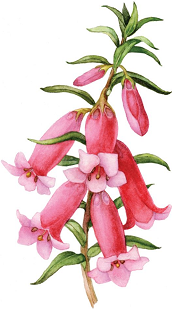Growing Australian Native Plants
Growing Australian native plants is great fun and very rewarding, but there are pitfalls. These pages cover the fundamentals of cultivating, caring for and propagating native plants. They are based on our members’ experience and will help you avoid those pitfalls.
Need advice? Advice from people with local knowledge is always available from your local APS district group.
>> District Group Locations and Contacts
Tips
♦ Most native plants prefer well drained soils
Building up garden beds, or underground drainage, can be beneficial.
♦ When adding soil, thoroughly mix it into the existing soil
Do not just spread soil on top of the garden.
♦ Eliminate weeds from the planting area
Especially those spreading by underground runners.
♦ Group plants needing similar growing conditions together
♦ Plants needing full sun rarely survive in shady situations
♦ Avoid over watering
♦ Most native plants grow well without extra fertiliser
High phosphate fertilisers may be harmful.
♦ Use mulches and groundcover plants
They help reduce weed growth and keep the soil cool, moist and friable.
♦ Lightly prune immediately after flowering
Light pruning promotes compact growth and more flowers.
Heavy pruning kills plants which reshoot poorly from old wood.
♦ Rejuvenating an old garden? >> Further Information
♦ Low water usage gardening >> Further Information
Comprehensive information on the use and cultivation of many species of Australian native plants can be found in:
>> ANPSA’s Native plant guides.
Soils
Some native plants are very particular about their preferred soil type, structure and pH (acidity / alkalinity).
For example, Banksias from Western Australia mostly grow in deep sand that has excellent drainage and will not grow in heavy soils.
Ensure you are familiar with the soils on your site and only select plants suited to them and your local growing conditions.
Planting Times
The time to plant natives depends on your climate and the type of plant.
Autumn is generally the best time, as it gives the plant time to establish itself before the next summer. In areas subject to frosts or cold below 2° C it is best to plant in spring after the cold has abated.
Precautions Against Frost Damage
Frost can damage or kill many plants – minimising frost damage is a consideration for every garden.
Most of Victoria is liable to frost – areas along the Great Divide and the adjacent slopes are amongst the most frost-prone parts of Australia.
Local knowledge is important in planning for frost because features of the landscape such as valleys and hills can channel or divert cold air as it flows downhill, creating microclimates which are significantly more or less frost-prone than the surrounding region.
Pruning
In natural conditions plants are constantly subject to pruning – animals eat the foliage and break branches as they trample through the bush. Unless the damage is severe the plants survive these set-backs and vigorous, healthy new growth follows.
Why prune? >> Further Information
Plant Propagation
The average home gardener using simple tools and methods can have a lot of fun propagating plants. ANPSA, our national body has comprehensive information on how to propagate plants:
